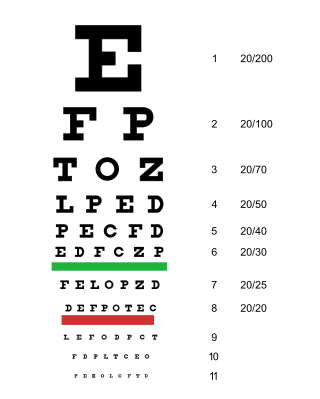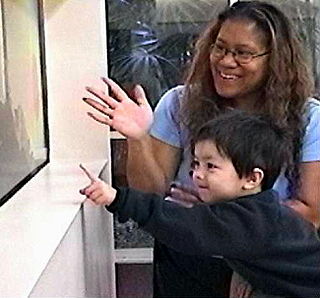
Asperger syndrome (AS), also known as Asperger's syndrome or Asperger's, is a diagnosis formerly used to describe a neurodevelopmental condition characterized by significant difficulties in social interaction and nonverbal communication, along with restricted, repetitive patterns of behavior and interests. Asperger syndrome has been merged with other conditions into autism spectrum disorder (ASD) and is no longer considered a diagnosis. It was considered milder than other diagnoses which were merged into ASD due to relatively unimpaired spoken language and intelligence.
Pervasive developmental disorder not otherwise specified (PDD-NOS) is a historic psychiatric diagnosis first defined in 1980 that has since been incorporated into autism spectrum disorder in the DSM-5 (2013).

Echolalia is the unsolicited repetition of vocalizations made by another person; when repeated by the same person, it is called palilalia. In its profound form it is automatic and effortless. It is one of the echophenomena, closely related to echopraxia, the automatic repetition of movements made by another person; both are "subsets of imitative behavior" whereby sounds or actions are imitated "without explicit awareness". Echolalia may be an immediate reaction to a stimulus or may be delayed.
A stereotypy is a repetitive or ritualistic movement, posture, or utterance. Stereotypies may be simple movements such as body rocking, or complex, such as self-caressing, crossing and uncrossing of legs, and marching in place. They are found especially in people with autism spectrum disorders, visually impaired children, and are also found in intellectual disabilities, tardive dyskinesia and stereotypic movement disorder, yet may also be encountered in neurotypical individuals as well. Studies have shown stereotypies to be associated with some types of schizophrenia. Frontotemporal dementia is also a common neurological cause of repetitive behaviors and stereotypies. A number of causes have been hypothesized for stereotypy, and several treatment options are available.
Amaurosis is vision loss or weakness that occurs without an apparent lesion affecting the eye. It may result from either a medical condition or excess acceleration, as in flight. The term is the same as the Latin gutta serena, which means, in Latin, clear drop. Gutta serena is a condition of partial or complete blindness with a transparent, clear pupil. This term contrasts with suffusio nigra which means, in Latin, dark suffusion, indicating partial or complete blindness with a dark pupil, e.g., a cataract. Milton, already totally blind for twelve years by the time he published Paradise Lost, refers to these terms in Book 3, lines 25–26.
The following outline is provided as an overview of and topical guide to autism:
Mind-blindness, mindblindness or mind blindness is a theory initially proposed in 1990 that claims that all autistic people have a lack or developmental delay of theory of mind (ToM), meaning they are unable to attribute mental states to others. According to the theory, a lack of ToM is considered equivalent to a lack of both cognitive and affective empathy. In the context of the theory, mind-blindness implies being unable to predict behavior and attribute mental states including beliefs, desires, emotions, or intentions of other people. The mind-blindness theory asserts that children who delay in this development will often develop autism.

Visual or vision impairment is the partial or total inability of visual perception. In the absence of treatment such as corrective eyewear, assistive devices, and medical treatment, visual impairment may cause the individual difficulties with normal daily tasks, including reading and walking. The terms low vision and blindness are often used for levels of impairment which are difficult or impossible to correct and significantly impact daily life. In addition to the various permanent conditions, fleeting temporary vision impairment, amaurosis fugax, may occur, and may indicate serious medical problems.
The Autism Diagnostic Observation Schedule (ADOS) is a standardized diagnostic test for assessing autism spectrum disorder. The protocol consists of a series of structured and semi-structured tasks that involve social interaction between the examiner and the person under assessment. The examiner observes and identifies aspects of the subject's behavior, assigns these to predetermined categories, and combines these categorized observations to produce quantitative scores for analysis. Research-determined cut-offs identify the potential diagnosis of autism spectrum disorder, allowing a standardized assessment of autistic symptoms.
Stereotypic movement disorder (SMD) is a motor disorder with onset in childhood involving restrictive and/or repetitive, nonfunctional motor behavior, that markedly interferes with normal activities or results in bodily injury. To be classified as SMD, the behavior in question must not be due to the direct effects of a substance, autism, or another medical condition. The cause of this disorder is not known.

Autism therapies include a wide variety of therapies that help people with autism, or their families. Such methods of therapy seek to aid autistic people in dealing with difficulties and increase their functional independence.

Self-stimulatory behavior, also known as "stimming" and self-stimulation, is the repetition of physical movements, sounds, words, moving objects, or other behaviors. Such behaviors are found to some degree in all people, especially those with developmental disabilities such as attention deficit hyperactivity disorder (ADHD) and autism. People diagnosed with sensory processing disorder are also known to potentially exhibit stimming behaviors.

Classic autism, also known as childhood autism, autistic disorder, (early) infantile autism, infantile psychosis, Kanner's autism, Kanner's syndrome, or (formerly) just autism, is a neurodevelopmental condition first described by Leo Kanner in 1943. It is characterized by atypical and impaired development in social interaction and communication as well as restricted, repetitive behaviors, activities, and interests. These symptoms first appear in early childhood and persist throughout life.
Autism, also called autism spectrum disorder (ASD), is a neurodevelopmental disorder characterized by symptoms of deficient reciprocal social communication and the presence of restricted, repetitive, and inflexible patterns of behavior. Autism generally affects a person's ability to understand and connect with others, as well as their adaptability to everyday situations, with its severity and support needs varying widely across the spectrum. For example, some are nonspeaking, while others have proficient spoken language.
Autistic catatonia is a term used to describe the occurrence of catatonia in autistic people. Catatonia is a complex behavioral syndrome typically characterized by immobility, withdrawal, abnormal movements, and abnormal behaviors. According to current diagnostic guidelines, its primary feature is that it causes patients to demonstrate one or more of the following: 1) decreased movement; 2) "decreased engagement during an interview or physical examination," and/or 3) "excessive and peculiar movement."

Hand clasping or hand folding is the interlocking of the fingers of one hand with the fingers of another. It is commonly used to express authority above or respect for others. It is also common to clasp the hands during prayer.
Sex and gender differences in autism exist regarding prevalence, presentation, and diagnosis.
Nonverbal autism, also called nonspeaking autism, is a subset of autism spectrum disorder (ASD) where the person does not learn how to speak. One study has shown that 64% of autistic children who are nonverbal at age 5 are still nonverbal 10 years later.
Social (pragmatic) communication disorder (SPCD), also known as pragmatic language impairment (PLI), is a neurodevelopmental disorder characterized by difficulties in the social use of verbal and nonverbal communication. Individuals who are defined by the acronym "SPCD" struggle to effectively indulge in social interactions, interpret social cues, and may struggle to use words appropriately in social contexts.
Deaf and hard of hearing individuals with additional disabilities are referred to as "Deaf Plus" or "Deaf+". Deaf children with one or more co-occurring disabilities could also be referred to as hearing loss plus additional disabilities or Deafness and Diversity (D.A.D.). About 40–50% of deaf children experience one or more additional disabilities, with learning disabilities, intellectual disabilities, autism spectrum disorder (ASD), and visual impairments being the four most concomitant disabilities. Approximately 7–8% of deaf children have a learning disability. Deaf plus individuals utilize various language modalities to best fit their communication needs.






